SONIC THE HEDGEHOG CD | SEGA | MEGA-CD/SEGA-CD
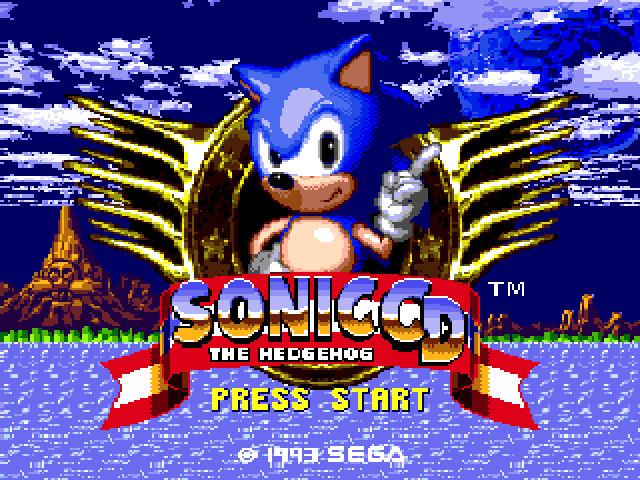
Jump to --> -[History]--[Story]--[Gameplay]- -[Zones]- -[Cheats and Tips]- -[Beta Versions]-
-[PC Version]--[Soundtracks (MP3's)]- -[Emulation]- -[Secrets]- -[Misc Info]-
Sonic The Hedgehog CD (Sonic CD) was the only release for SEGA's mascot on their first CDROM system. At the time it marked Sonic's 3rd game and introduced two new characters: Amy Rose and Metal Sonic.
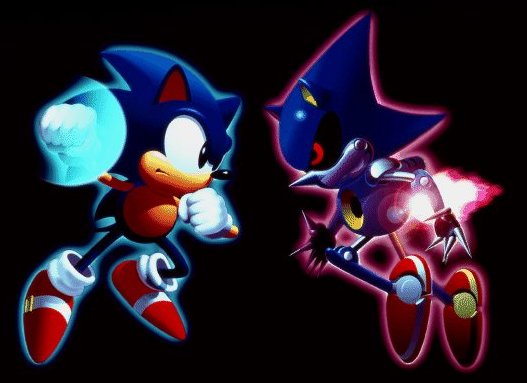
In relation to the other Sonic games of the 16-Bit era, Sonic CD was perceived more of a cult game as it fell somewhere outside of the Sonic lineage established by Yuji Naka. This is for two reasons: it was released on a system that never became popular was perhaps moreover, not developed by SEGA Technical Institute (STI) or Sonic Team (though some members had involvement) whom by now had established a style. The game was headed by Sonic's character designer Naoto Ohshima and it offered a slightly different vibe. Examples are that animals are not released but instead flowers, and the exclusion from the recently introduced Tails was another disconnection from the Sonic norm.
That said however, as a standalone game, it is easily the best platformer on the system and hailed for its soundtracks being some of the best known created and possibly because they were so divisive should create a place for it in any retro collection.
HISTORY
Sonic The Hedgehog and its sequel had become one of the hottest properties in gaming was selling cartridges on the Mega Drive/Genesis by the bucket load with Sonic 2 becoming one of the best selling 16-Bit games of all time.
SEGA's Mega-CD/SEGA-CD system has been released to a luke warm reception and was showing signs of falter. It was a logical step for SEGA to being their hottest property to this new technology/platform. It should be noted that the advent of Sonic CD also set a precedent which would come into play on SEGA's next platforms: the 32X and the Saturn, but that's another story.
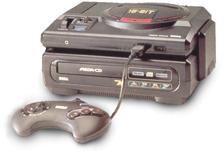
SEGA's Mega-CD/SEGA-CD Addon
Announcement
The announcement of development came in the gaming press in early 1992. There was no actual details on the game but speculation grew since Sonic 2 for SEGA's other platforms were known to be in development and the press attention these games were getting was intense.
It was assumed that the game could be an enhanced version of the original Sonic The Hedgehog or of the upcoming Sonic 2. Enhancements meaning an animated introduction and CD audio (Redbook). There was good reason for this as one main reason the Mega-CD/SEGA-CD was faltering was for its collection of "hand-me-down" titles: ergo slightly enhanced cartridge games.
This was a common practice in the gaming press of the time especially where Sonic games were concerned.
Others remained hopeful that SEGA of Japan's coders (SOJ) would create the ultimate in Sonic entertainment. The potential of a Sonic game running on more powerful hardware created hype for the game before any screenshots actually appeared and thankfully, it was decided that an entirely new game was to be created that would take advantage of SEGA's new kit.
Development
SEGA gave a free reign of development to Naoto Ohsima as Director and pressure from the company was directed more to STI whom had moved to San Francisco prior.
Early the development some cross-discussion took place between him and STI/Sonic 2 Team about what their respective games were about. Whist the Time Travel element had been floated as a potential element in both games, the Sonic 2 team/STI decided against and Sonic CD take shape from here. Oshima believed that zones where Sonic was suddenly changing around him would be unique and mesmerizing.
However, programming this instantaneous change in environment proved to be unattainable and not without great effort with comments relating to programming difficulties (apparently the game uses a modified version of the original Sonic The Hedgehog programmed by Yuji Naka) and capability of the hardware, thus the sequence of Sonic trailed by stars against a fuzzy green backdrop masks the loading/processing required as Sonic moves from one timeframe to the next.
Hiroyuki Kawaguchi became the art director and wanted to make each zone visually stunning that had not yet been seen the franchise.
It was part of the efforts to make this game different.
New Characters
Ohshima also wanted to expand the cast of characters and have an enemy that was on par with Dr. Robotnik.
Amy Rose was based on an existing character from the Sonic The Hedgehog Manga. Instead of a usual setup of a couple with romance, a twist where she would be infatuated with Sonic yet he would return no such emotion instead seeing her rescue as another task was derived avoiding a well used kidnapping and rescue scenario.
Metal Sonic (not to be confused with the Mechna-Sonic's in Sonic 2 and Sonic & Knuckles) was supposed to be a robotic equal to Sonic crafted by Dr. Robotnik.
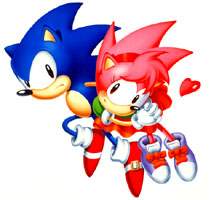 |
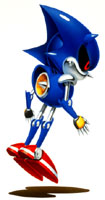 |
This sleeker, meaner and cooler looking version styled by the games visual director Kazuyuki Hoshino became the longstanding primary robotic design of Sonic and was well publicised before the games release.
Reveal
In the Spring of 1993 the first screenshots of the game were seen. However, it was not of the gameplay. These depicted the animated introduction. Upon viewing it confirmed fears of some gamers hoping for more. The question of the gameplay had not been answered.
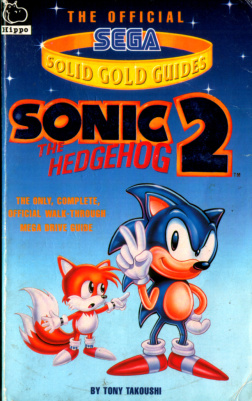 |
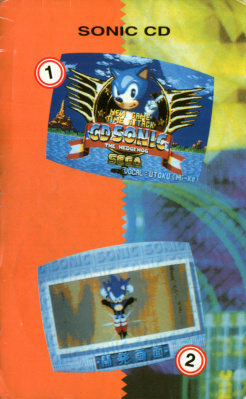 |
 |
 |
Just a few short months later, the Japanese gaming press acquired screenshots of the actual gameplay. They detailed that the game was indeed another platformer with gameplay appearing very similar to Sonic 2 with some fantastic graphics, but the game was revealed to have an additional element no other Sonic game possessed: Time Travel. The game was provisionally entitled Sonic Through Time.
In the game Sonic would be able to access the past and future of any zone he was in. In the different timeframes Sonic could put right the wrongs done by Dr. Robotnik and his new evil Metal Sonic creation. In addition the relatively large amount of RAM in the system meant that zones could be much larger and contained intriguing new features/mechanics.
Releases (1993)
The first release was in Japan on September 23rd. Reviews of the game were highly positive with review scores of 85%+. This was followed by Europe in October.
The US version of the game was delayed by SEGA of America (SOA) and released November 19th in order for a distinctly different rock orientated soundtrack to be created wanting the game stand out in the systems library. The Japanese/European versions had sported a more fantasy influenced vibe with samples from music of the era still recognised today and vocals from J-Pop artist Keiko Utoku who also voiced Sonic.
Creating this new soundtrack was tasked to Spencer Nilsen and he studied the original soundtrack and knew what SOA wanted to achieve. This new rock and ambient soundtrack had lyrics from pop/jazz female trio Pastiche whom provided the lyrics to the theme song "Sonic Boom" to represent the female element of Amy Rose.
Gamers of their respective versions had no idea of the replacement however and once it became known, it polarised the fans of the game as to which was the better soundtrack something which continues to this day. Once the controversy abated the vast majority had an appreciation for both.
Both soundtracks can be downloaded via this feature.
Along with the soundtrack change was curious rewriting of the games story in the manual. The character of Amy Rose was renamed to Princess Sally (which is was another character from the Sonic The Hedgehog anime) and there was romance between her and Sonic.
This was probably an attempt by SOA to cross market these two products, however, since it was fairly obvious, that this Princess Sally looked nothing the brown squirrel used in the TV show and that Sonic was not really into her, it went largely ignored and subsequent re-releases dropped this.
Though the game did not become a phenomenal success the Mega-CD/SEGA-CD needed badly it was an excellent example of a Mega-CD/SEGA-CD game showing what the hardware was capable of, specifically the new special stages making extensive use of custom hardware which until now had hardly been used and outstanding use of CD audio.
Sonic CD though was to be played by relatively few people and never got the recognition that it deserved.
Ports
In 1996, it was ported to the PC for Windows 95 under the SEGA PC brand and was included by some manufactures with their new PC's.
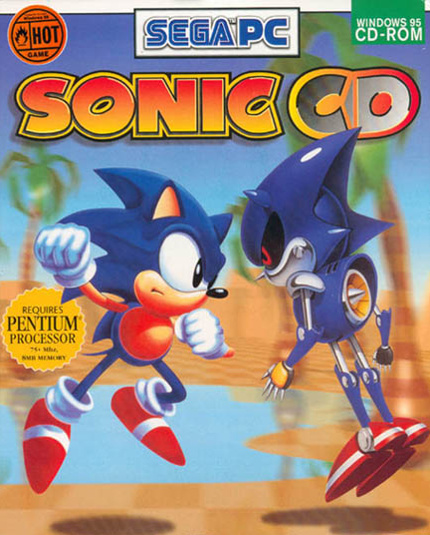
PC Version
As PC gaming and using Windows 95 for such was still a relatively small market, again only a few people played even though demos were distributed on some platform magazines of the day.
Sonic Mega Collection (and Plus) released in 2003 (multi-platform) has remnants in the form of redundant menu items that lead to the intended inclusion of the game.
There were conflicting reports as to why it was not included. One was that SEGA's own Mega-CD/SEGA-CD emulator was not up to scratch and they have still yet to use an emulator for this hardware in any of their compilation titles.
The other reason was due to space constraints which Yuji Naka commented on, however, it was somewhat known that he had no particular love for the game anyway.
Since the PC version was ultimately included, this lends more credence to the theory of their emulator being crap even though Mega-CD/SEGA-CD emulation (including the 32X add-on) has been available for several years prior.
So it was not until almost 10 years later that versions became available on other consoles. With the release of Sonic Gems Collection for Gamecube and PS2 players were finally able to experience this niche game which over the years had gained the attention of gamers and Sonic fans alike thanks in part to Sonic fansites, downloading of the demo and the dark art of emulation.
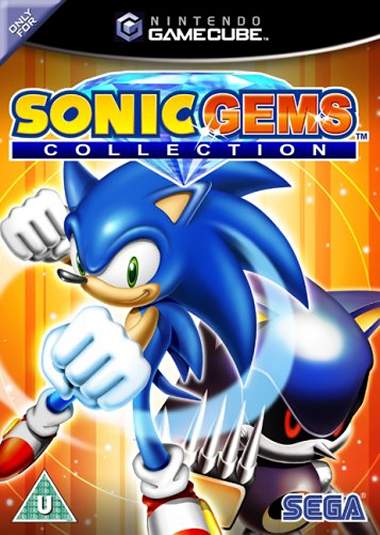
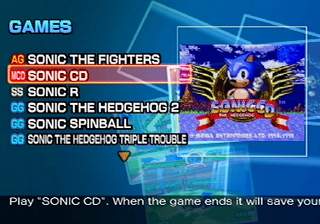
Sonic Gems Collection Case Scan and Screenshot
For that compilation, it was a very basic port of the PC version and ran very speedily on these consoles. This version again had the US soundtrack though it was possible to get some of the Japanese music via cheat codes on the PS2 version only.
A Remastering
The version of Sonic CD contained in the Sonic Gems Collection had irritated many and an individual a member of the Sonic hacking community rather than SEGA themselves called Christian Whitehead aka "The Taxman" set about correcting this.
In 2011, an upgraded version of the game was released in digital format for Xbox 360 and PS3 after interest from SEGA (as it seems they were unable to make decent ports of anything at that tine) and overall it fixed many issues and shortcomings the original game had.
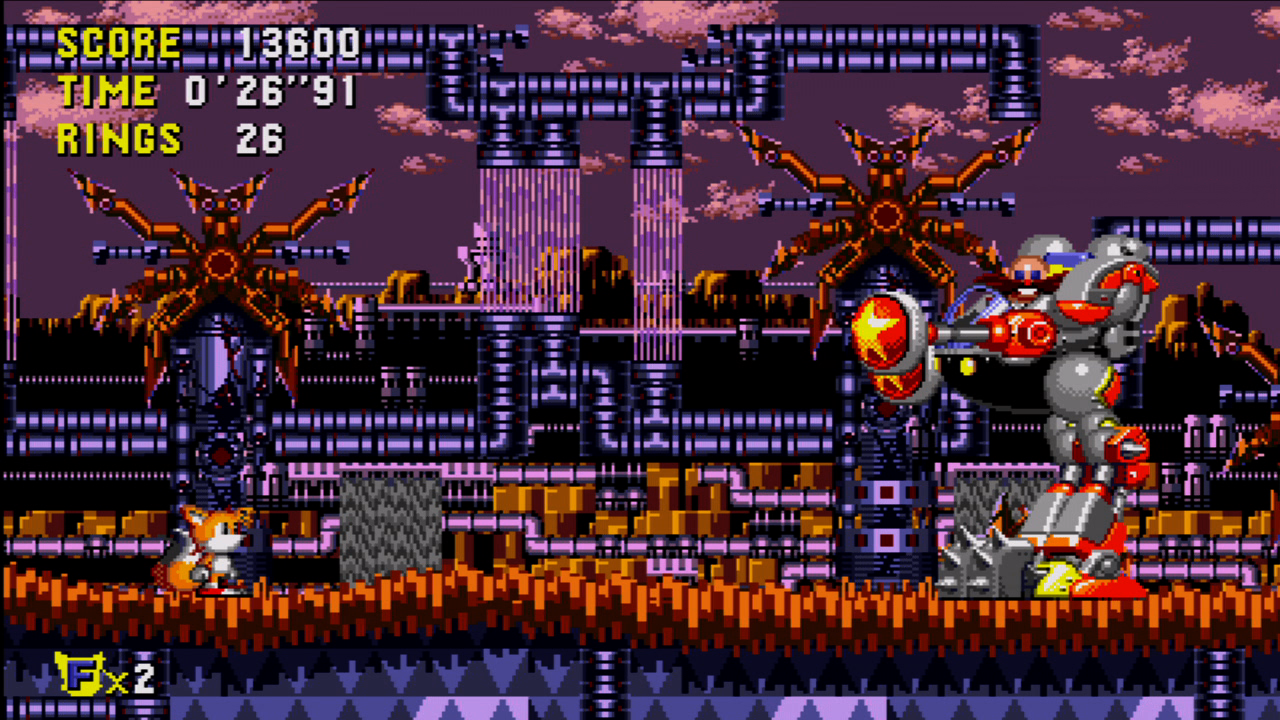
Sonic CD (2011) Xbox 360
It had many enhancements aside from the HD upgrades in graphics in sound. It had the option to switch between soundtracks, have Tails as an unlockable playable character and a tweak to the Spin-Dash. The full low down on this version is detailed below. It was very well received.
In 2013, this remastered version was released on PC via Steam, iOS, Android and the Ouya console for small prices.
Legacy
The average gamer probably had little knowledge of this game existing long ago and ultimately, the game itself fittingly has travelled through time to become available to the masses from a tiny audience.
So where does it sit? Well, it is not a sequel to the original Sonic nor is it a sequel-split something a few of SEGA's franchises did such as Shinobi and Wonder Boy.
It's probably best described as a co-exist and opinion in the Sonic community about whether this is the best Sonic platforming experience is still divided.
For those interested in obtaining the game and using Ebay, a copy of the original Mega-CD/SEGA-CD version costs around £30, the PC version around £10.
STORY
Little Planet is a mysterious world that orbits Mobius. It is only visible once, on the last month of the year over a place called Never Lake. What makes Little Planet weird is its relation to time. It has none. Seven Time Stones of immense power exist on this world altering time and change everything around them.
Our resident mad scientist Dr. Robotnik has his sights on Little Planet and the Time Stones. He has already conquered the planet in its past and controls its future.
Sonic arrives on the scene. He discovers Little Planet tethered by a giant chain to one of Robotnik's mountain fortresses. The surface is layered with gleaming metal.
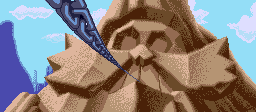
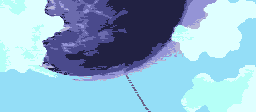
Anticipating Sonic's arrival, Robotnik is more prepared for this encounter. He has created a robotic version of Sonic programmed to destroy our blue hero. Feeling confident that his creation will succeed he sends it to capture Sonic's self anointed girlfriend - Amy Rose.
Sonic contemplates the view of Little Planet now enslaved. As he does, something rockets over his head. Before he has chance to respond Amy shrieks as she is snatched up. She and her captor disappear in a blue streak of light.
Sonic stands on a tall rock. Robotnik now has the mysterious Little Planet and now Amy. At least he does not have the Time Stones. Sonic must acquire them before he does.
His adventure on Little Planet will be quite interesting...
Other versions coming soon...
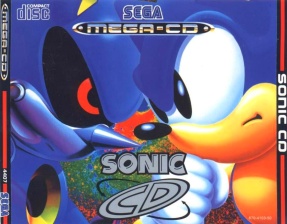 |
 |
European |
|
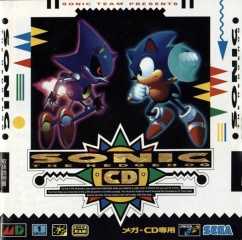 |
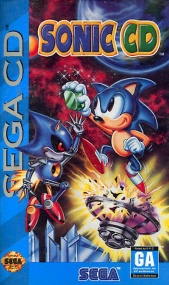 |
Japanese |
US |
GAMEPLAY
When the game boots, the title presents you with four initial options: New Game, Continue, Time Attack and RAM Data.
The core gameplay in Sonic CD remains the same and the original Sonic The Hedgehog on the Mega Drive/Genesis. In fact some of Sonic's sprite animation is the same. So the game consists of the usual running through obstacle littered landscapes, collecting rings, special items and destroying the robots to reach the goal. However, in Sonic CD this is only the basic. The Time Travelling adds another dimension where your goal is to restore the timeline in each zone. Sonic CD forgoes the use of acts to separate each zone into its three parts.
The game offers a fair challenge unless will to invest in the Time Travelling mechanic.
The game benefits from the extra processing power as the graphics are better and there is much more activity in the background layers. That said, there is some slowdown especially when Sonic looses his rings.
On the title screen, selecting NEW GAME starts a new game and new save file.
Progress through the game is automatically saved and can be resumed by selecting CONTINUE on the title screen.
The D-Pad moves Sonic left and right. Holding a direction makes him run.
By pressing DOWN whilst running makes Sonic roll. This move is used for attacking enemies, breaking though walls where possible and gaining speed such as when whizzing around 360o loops.
Being stationary and holding UP or DOWN for a few seconds scrolls the screen slightly in that direction for a small preview. Useful before leaping down a shaft or a platform above where an enemy could be roaming.
All buttons are JUMP. A tap will produce a small jump and a press will produce a larger jump.
Sonic now has two special abilities:
Spin-Dash - It was first introduced in Sonic 2 it is useful for getting up steep hills and loops. By holding DOWN on the D-Pad and holding any button, Sonic will spin on the spot. Release the button to blast off at speed.
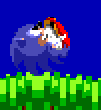
Super Peel Out - Is performed by holding UP on the D-Pad and holding any button. Sonic will rev up on the spot and his legs will become a figure 8. Release the jump button to blast away at speed.
Whilst the Peel Out looks cool is has a disadvantage: Sonic is vulnerable and its very possible to run right into a danger.
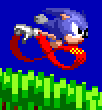
When Sonic comes into contact with certain objects e.g poles, he may hold onto them. Use the D-Pad to move up and down.
START - Pauses the game.
As always, throughout play, onscreen at all times will be: Score, Time, Rings and Lives remaining.
Enemies, Hazards and Mechanics
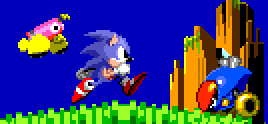
Each zone is loaded with enemies in the form of robots, hazards such as spikes and flames and mechanics to play around which can be transporters, giant fans and electrifying floors!
When hit by an enemy or hazard rings will scatter about the screen and there is a small window in which to reclaim some of them. A hit with no rings will kill Sonic.
Enemies can be destroyed with by single hit either by being rolled at or jumped on and in their place will be a flower. Most are easily vanquished but beware that some of these will fire projectiles or have moments where they can not be destroyed.
Beware that some mechanics can crush Sonic resulting in instant death.
The game begins with three lives. Extra lives are obtained for every 100 rings collected, every 50,000 points and by smashing open monitors with Sonic's face on.
Upon loosing all lives Game Over occurs. It is possible to continue if you have credits which are earned via the Special Stage. When using a continue credit Sonic will be taken back to the beginning of Zone 1.
The end of a zone if pre-advised by a Goal sign. There can be no backtracking after this.
The end of a zone is signified by the familiar spinning post/sign and by possessing a minimum of 50 rings allows entry to the Special Stage done by leaping into the giant ring to the top-right.
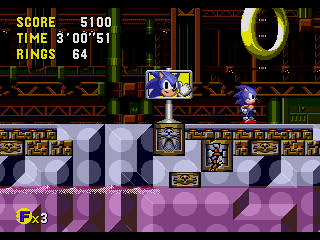
Goal and Special Stage Entrance
There is a time limit of 10 minutes to complete a zone. Instant death occurs at 10 minutes. A zone can be restarted at any time by pausing the game and pressing BUTTONS A+B+C. Also should you leave Sonic standing idle for three minutes he will say "I'm out of here" and run off the screen. The game will restart.
Each zone or area consists of three smaller zones (Sonic CD does not use the term act) and when Sonic is in either zone 1 or 2 he can Time Travel backwards and forwards. Zone 3 will always take place in the future and ends when the capsule is destroyed.
Special Items
In each zone, the following special items found in monitors are up for grabs:
 |
Ring - Gives 10 rings. |
 |
Shield - Gives Sonic a protective barrier. Will protect against 1 hit. |
 |
Invincibility - Makes Sonic invincible for a short time. He will be trailed by stars. Note that he can still drown. |
 |
Speed Boots - Provides a temporary boost in speed. |
 |
Sonic - An extra life. |
 |
Lampost - These are restart markers should Sonic be killed. |
  |
Past and Future (Time Travel) Posts - Allow Sonic to travel to different timeframes of that zone. Detailed below. |
Time Travelling
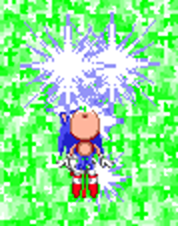
The key element to the game is the use of Time Travel which will effect the future outcome of a zone and ultimately the entire game. All zones one and two begin in the present regardless as to which timeframe Sonic left in the previous and are littered with lampposts labelled PAST and FUTURE. By running past one of these, Sonic is tagged and by building up speed, Sonic will have a trail of stars. Keep these for approximately five seconds and Sonic will warp to that timeframe.
Slowing down or halting will abort.
It is possible to travel as many times as there are posts.


The lives counter (bottom-left) will indicate which timeframe Sonic is in.
P=Past, F=Future and Sonic = Present.
The use of Time Travel gives each zone four potential appearances:
Past |
Future |
See how that zone looked in the past. Here Robotnik has already introduced Botniks. A power generator for them is inside the zone somewhere. By destroying this, all of the enemies in the zone will be destroyed and thus those in the present and future resulting in a good outcome. In addition, a hologram of Metal Sonic will be around harassing the local wildlife. By destroying the hologram generator next to him all the wild life will be happy. How sweet. 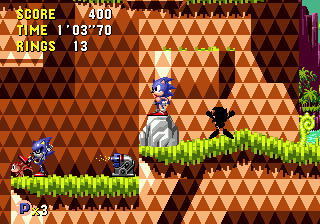 Travelling to the future from here will return to the present. |
See how this zone looks in a distant future. There are two possibilities: good and bad which is dependant on Sonic actions in the past. With a bad outcome, Robotnik has long since taken control and created a dark, grimy and polluted mess akin to all those factory style industrial zones he always hangs around in. With a good outcome the natural timeline is restored. There will be no trace of Robotnik's intrusion and there will be a perfect balance of clean environment, technology and wildlife. Travelling to the past from here return to the present. |
What version of the future shown in zone three will depend on Sonic's actions in zones 1 and 2.
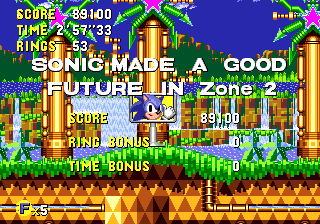
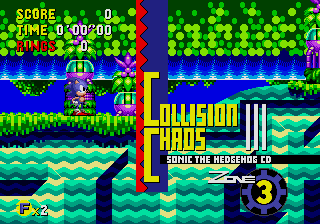 |
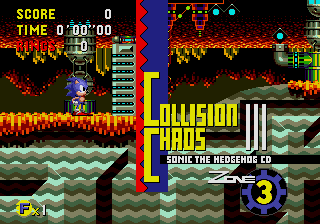 |
A Good Future |
A Bad Future |
Note that it is possible to play the game through by not using Time Travel but that's not very exciting. You may design to time travel for change of sceney and music.
Special Stages
In these stages Sonic continuously runs around a flat obstacle course loaded with dead ends and other hazards to make things tricky. The goal is to destroy the UFO's that hover about within the time limit.
Each special stage is different and when progressing through them the courses will be more complex, there will be more UFO's and these will become more difficult to destroy as they will manoeuvre faster and become evasive.
The D-Pad LEFT and RIGHT is used to steer Sonic and any button is jump. A tap for a small leap and a press for a full height. The art of finishing these stages is timing the jumps well.
Special Stage Mechanics
Water - The biggest problem in these stages will be the water. Touching it will deduct 10 seconds from remain time. It will also slow Sonic down. Avoid where possible.
Chopper Blocks - Will make Sonic fall flat on his face and slide out of control for a small period before coming to a stop as well as loosing some rings.
Dash Zones - These blast Sonic along in their pointing direction which is usually ok but will make Sonic unresponsive for a second or two.
Rough Ground - Will look like a speckled track and will simply slow Sonic down.
Barriers - The pinball-esqe walls will simply rebound Sonic off them. Generally not disastrous unless caught between two where there is water.
Springs - Will provide a very high bounce. Useful for crossing expanses of water. Beware when landing.
Fans - Similar to fans but Sonic will keep most of his momentum. It is still possible to destroy a UFO when swirling in the air so can sometimes be useful as there is a more controlled descent from them. Beware when landing.
When successfully destroying a UFO they will grant the following rewards:
Rings - These are exchanged for points at the end of the stage.
Speed Boots - A temporary boost in speed.
Time - 30 seconds extra time. This UFO will have red stripes and will only be visible in the last 20 seconds and roughly in the centre of the course.
A special stage ends when all UFO's have been destroyed. A Time Stone is awarded. There are seven to collect. Whilst there is no Super Sonic ability, upon collection of all the Time Stones each zone/area of Little Planet will have its temporal continuity intact ergo all good outcomes thus no need to travel to the past and destroy the generators.
Bonus points are then awarded for any remaining time and rings. A continue credit represented by Extend Player is given for having over 100 rings.
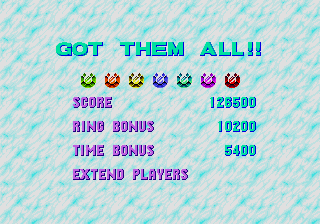
Special Stage Time Stones
The special stages make heavy use of the custom sprite scaling chip inside the system and was one of the first games to do so. It creates the pseudo-3D environment Sonic runs though.
Time Attack
Introduced in Sonic CD was the Time Attack mode something which remains a part of many Sonic games today. In this mode any zone already completed can be played against the clock. The best three times and the player's initials are recorded and saved.
There is more to this mode however, as the total of times recorded determines whether extras in the game are unlocked. These times are displayed at the bottom left.
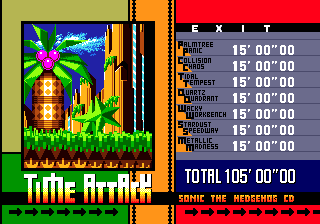 |
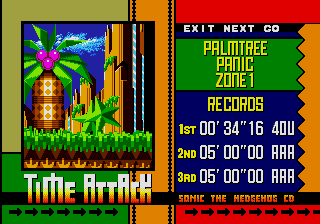 |
Extra's
Time Attack Special Stages - By having a total time within 30'21"05 allows the play of the Special Stages.
Press LEFT at the Time Attack Zone Selection screen.
D.A Garden - By having a total time of less than 37'27"57 the option for D.A GARDEN will be on the title screen to the left of RAM DATA.
It is an enhanced sound test with an interactive image of the planet Mobius.
By holding down BUTTON B and using the D-Pad the planet can be rotated.
By holding down BUTTON C and using the D-Pad the planet can be zoomed.
BUTTON A plays music.
Visual Mode - By having a total time within 25:46:12 a VISUAL MODE option appears next to the left of D A GARDEN on the title screen.
This mode shows the videos in the game and numerous images.
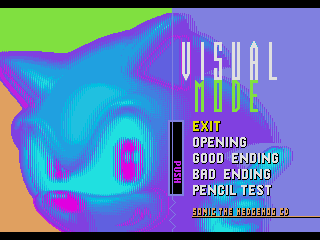
Visual Mode
Having the most initials after completing all the zones greets the player with a screen of Sonic, Amy and Metal Sonic frolicking with animals with the text "congratulations [players initials] you are the greatest player!"
The programmers of the game included their best times in the form of a cheat.
RAM Data (Memory Management)
This option on the title screen is a utility allows the moving of Sonic CD game data to and from the systems internal battery back-up RAM and RAM cartridges. A save file will take approx. 11 units of internal RAM. If there is not enough available when the game boots an image of Robotnik is displayed with a warning.
Another use of this utility is to backup a saved game file. This is useful because when playing the game on a real system I've become annoyed that the game overwrites any existing save file with the default name when ever a new game is started. This can be especially so when you have collected all the Time Stones or have excellent Time Attacks. This can be avoided by making a backup up the file you already have.
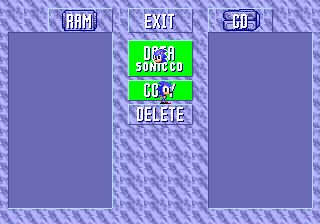
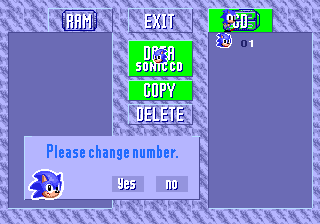
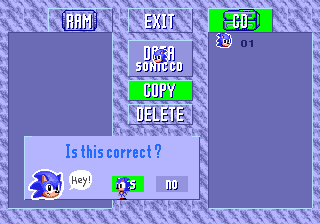
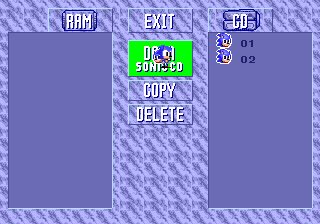
This procedure also works on emulators however there is usually a save state feature of that particular program.
Procedure
At the title screen select RAM Data. When the memory manager loads press DOWN and highlight Data Sonic CD.
Press A and Sonic will move and highlight COPY.
Press A again. Sonic will jump and move to where data is stored; either your Mega-CD or RAM cartridge, default being your Mega CD internal memory.
You will be prompted to change the number of the file.
Anything above 00 will not be overwritten each time you start a game.
Confirm and the file will be copied.
You can make more than 1 copy should you desire. The drawback to this is that it will make the game consume some more internal backup ram for each copy you want.
THE ZONES | SCREENSHOTS
The journey of Sonic CD will be through seven distinctive zones, each divided into three smaller zones (Sonic CD does away with the word act) along with seven Special Stages to complete.
There are two endings to the game and the best ending is when Sonic is in possession of all the Time Stones.
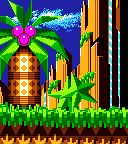
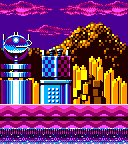
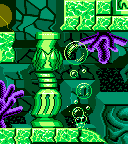
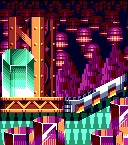
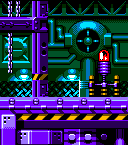
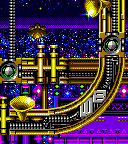
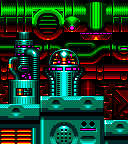
Palm Tree Panic
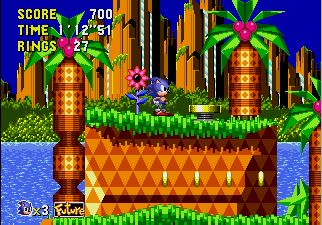 |
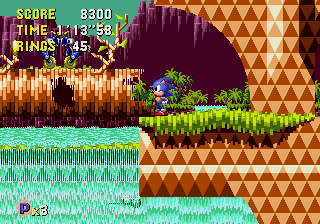 |
Present |
Past |
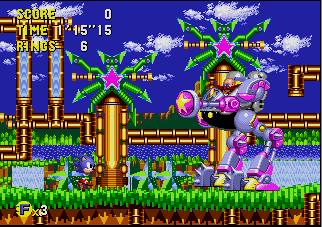 |
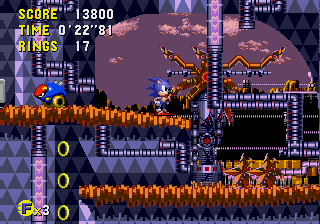 |
Good Future |
Bad Future |
Palm Tree Panic is a tropical delight of any Sonic game. Palm trees, waterfalls and lush greenery set against triangle patterned hillsides create a pleasant environment.
Amy makes an appearance at the end of Zone 1 just near the goal. She will attach herself to Sonic so be prepared with a good leap to evade her.
In this first encounter, Robotnik attacks using his EGG-HVC-D01. Sonic will rebound off the bumpers on the arms when jumped at. He is weakest when he drops them and prepares to charge. Only three hits are needed to defeat him.
Collision Chaos
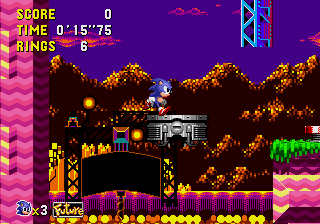 |
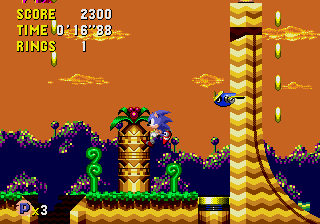 |
Present |
Past |
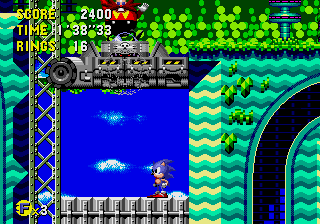 |
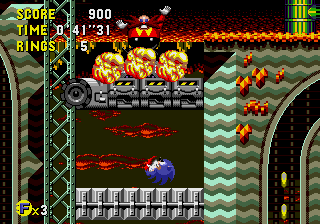 |
Good Future |
Bad Future |
This is the vibrant pinball themed zone for making Sonic ricochet around the screen and this will happen much more so than Spring Yard Zone or Casino Night Zone as its populated with hundreds of arranged bumpers, flippers and springs.
At the start of Zone 1, Amy still adoringly follows Sonic only for Metal Sonic to appear and take her away. Now the second part of the quest begins.
The fight with Robotnik takes place inside a Pinball Fortress. He is tucked in towards the centre dropping bombs. Use the flippers to smash the glass beads and head up to attack from underneath.
It is worth exploring the side tubes as there are some ring monitors and extra life.
This is one of those tricky fights where his baldness can be defeated either very quickly or irritatingly not.
Tidal Tempest
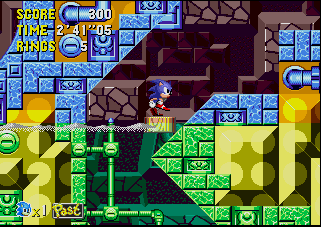 |
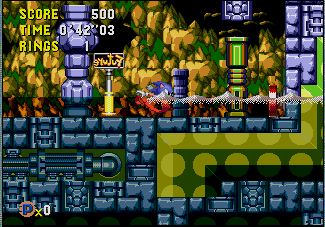 |
Present |
Past |
 |
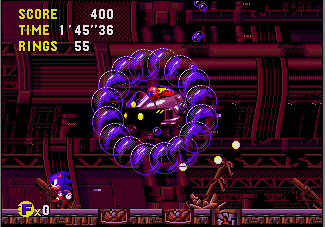 |
Good Future |
Bad Future |
The staple underwater zone with variable water levels. Sonic is at half speed when submerged and in danger of drowning. Routinely replenish air supply via the bubbles on the floor.
Along with plenty of pipes and vents to explore, there are a good number of walls with stashes of special items. Fans create currents that drag the hedgehog around.
The confrontation with Robotnik takes place after a downwards chase through some chambers. These are worth exploring for several ring monitors, extra life and invincibility.
When submerged, he will surround himself with a rotating barrier of air bubbles. Inhaling them all will make him vulnerable and prevent Sonic from drowning. Scoring one good hit between the projectiles will be enough to make him retreat.
Quartz Quadrant
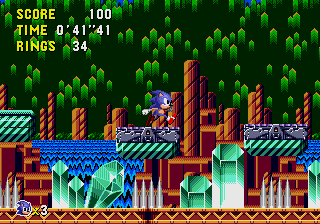 |
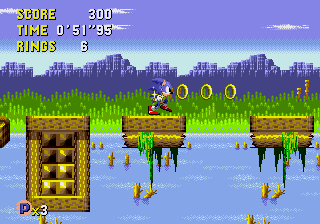 |
Present |
Past |
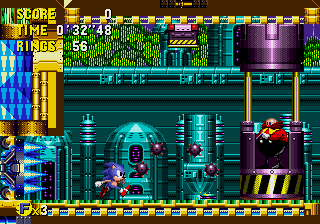 |
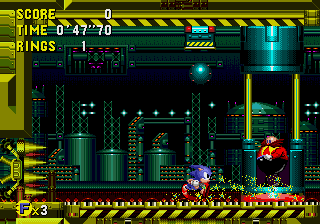 |
Good Future |
Bad Future |
Sonic entered an enchanted turquoise cave network decked with valuable gems. A mining operation is underway and thus there are plenty of conveyor belts on almost every platform controlled via switches. There are tunnels and shafts also.
In a somewhat restricted fight with Robotnik, Sonic must simply maintain speed and work the conveyor belt against his capsule. Beware the cluster mine dropped from the ceiling as they break into four. Friction will eventually wear the capsule down making it explode.
Prior to entering this chamber there are many special items that can be collected so it pays to explore.
Wacky Workbench
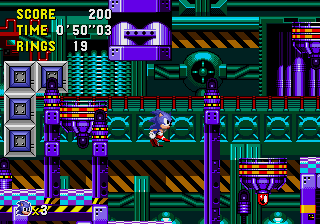 |
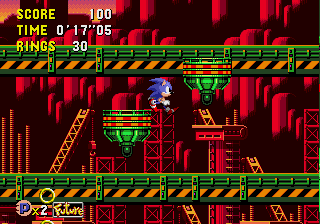 |
Present |
Past |
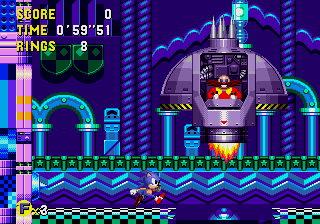 |
 |
Good Future |
Bad Future |
Possibly the most difficult zone of the game and for the most part down to the entire floor of the zone being electrified. The effect of this is everything including platforms and moreover Sonic, is instantly blasted directly upwards when touched.
Other dangers are electrical discharges from a suspended power grid and instantly freezing exhausts turning Sonic into a block of ice. An immediate jump when hitting the floor allows escaping unharmed.
In zone 1 in the bad future, hidden near the beginning is a large Robotnik statue. If you find it, it will spout spikeballs at you. In the Past, there's a statue of an angel in its place that gives you rings.
Robotnik appears and drill upwards through the ceiling. Chunks of the floor above will drop down. Ride one of these when the energy beam electrifies the floor. When having travelled up a level score as many hits as possible (usually 2). On the third ride be sure to jump off onto the floor otherwise Sonic will be crushed by the ceiling.
Again, there are a few special items that can be collected so it pays to explore before the encounter.
Stardust Speedway
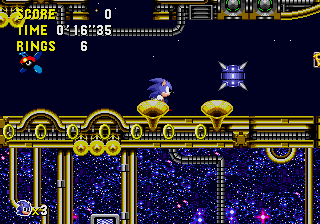 |
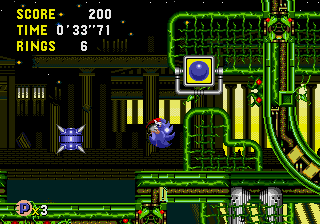 |
Present |
Past |
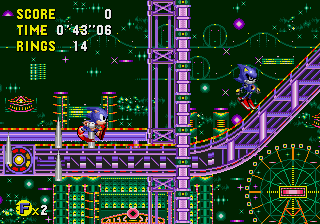 |
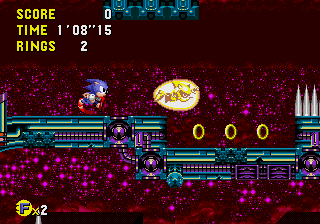 |
Good Future |
Bad Future |
Suspended very high in the air it is a network of rails, switches and pipes against the backdrop of twinkling city lights below and stars and it is the fastest of the zones.
The appropriate switches must be activated in order to progress. Dash panels rocket Sonic as he runs over them allowing him to reach some serious speeds around the various loops and steep ramps.
Sonic finally faces off with his wench stealing counterpart Metal Sonic. This is a deadly race whilst Robotnik follows with an instant kill laser.
If successful, Metal Sonic is battered and Amy can be released.
Metallic Madness
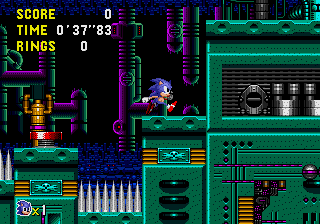 |
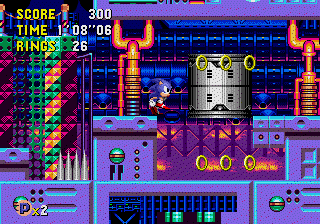 |
Present |
Past |
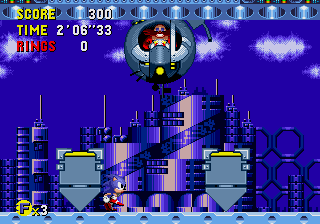 |
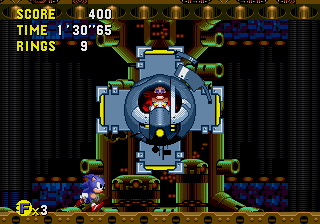 |
Good Future |
Bad Future |
The final technological zone filled with all manner of nasty contraptions including magnets, buzzsaws, smart bombs and spikes. A network of tubes is around.
In this zone, Sonic becomes reduced to less than half his size via a shrink ray. The expander ray must be found to return to normal.
There is no Metal Sonic hologram in this zone since he was defeated in the previous zone.
In this final fight, our Dr. has a simple but effective solution that requires precision timing to land a hit successfully. Five hits are needed to defeat him. It is slightly anti-climatic.
The four "arms" that rotate around his module break off in a different direction and when one does so that attack alters.
Special Stages
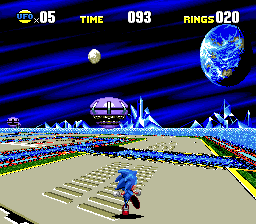 |
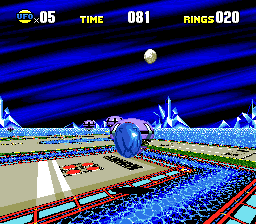 |
Special Stage 1 |
Special Stage 1 |
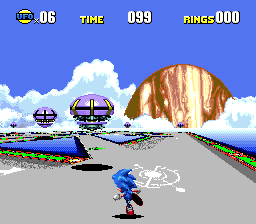 |
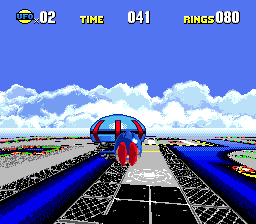 |
Special Stage 2 |
Special Stage 2 |
 |
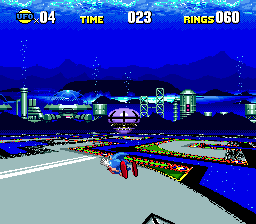 |
Special Stage 3 |
Special Stage 3 |
 |
 |
Special Stage 4 |
Special Stage 4 |
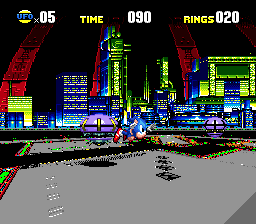 |
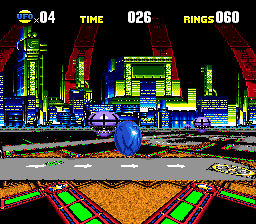 |
Special Stage 5 |
Special Stage 5 |
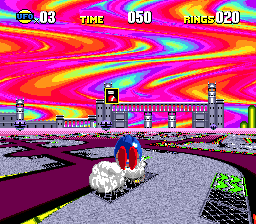 |
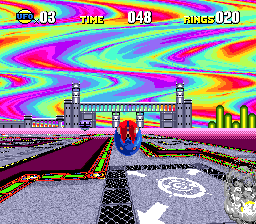 |
Special Stage 6 |
Special Stage 6 |
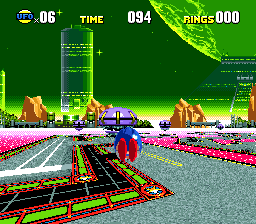 |
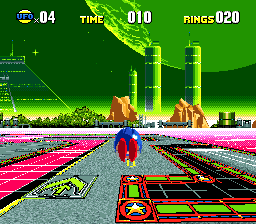 |
Special Stage 7 |
Special Stage 7 |
Each special stage is set against a different fantasy orientated backdrop ranging from floating islands with waterfalls to futuristic colonies all of which create vibrant and colourful landscapes.
There are seven official stages and a secret eighth (accessible via a cheat) that has Robotnik's face as the background. This extra Time Stone has no effect on the game.
CHEATS AND TIPS
Several of these cheats also display secret bonus content.
Stage Select
At the title screen as Sonic is waving us finger, press: UP, DOWN, DOWN, LEFT, RIGHT then B.
A ring sound will confirm the cheat has worked. Any zone in the game can be selected. The first number is the zone number and the second is the sub-zone number. The letters in the selection denote the following:
A = Past
B = Present
C = Good Outcome
D = Bad Outcome
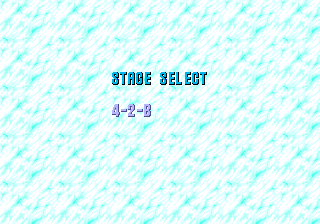
When a zone is completed the game will return to the title screen.
Other selections are the opening video and coming soon graphic which was part of the Beta version of the game.
Sound Test
At the title screen press: DOWN, DOWN, DOWN, LEFT, RIGHT then A.
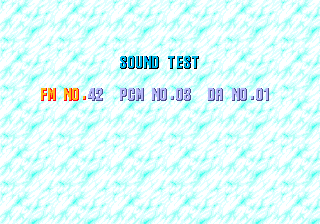
The CD audio (DA), PCM (PCM) audio generated by the Mega-CD's/SEGA-CD's sound chip and the effects (FM) generated by the Mega Drive/Genesis sound chip.
However, by setting the following combinations and pressing START a collection of images can be seen.
FM42, PCM03, DA01 DJ Sonic
FM46, PCM12, DA25 SEGA Forever
FM42, PCM04, DA21 Demonic Sonic
FM40, PCM12, DA11 See You Next Game
FM44, PCM11, DA09 Yuakuru
Secret Special Stage
By setting FM07, PCM07, DA07 at the sound test a Robotnik themed eighth special stage can be played.
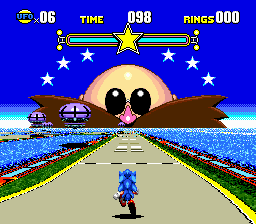
Debug Mode
There are two methods to activate this however, the simple method is to press START on controller 2 whilst a demo is playing. The score should change.
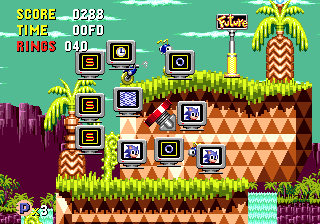
Alternatively activate the Sound Test cheat (see above) and set FM40, PCM12, DA11 and press START. A Screen with a picture of Tails should appear with the text "See You Next Game - Judy Totoya". Begin a game and Debug Mode should be active.
During this mode, press BUTTON B to change Sonic into an object, BUTTON A to change into another object and BUTTON C to place that object onto the screen.
Cleared time for zones in Debug Mode will be 0:00
This mode can be used to discover several secrets about the game...
Programmer Time Attacks High Scores
At the title screen press RIGHT, RIGHT, UP, UP, DOWN then C to see the quickest completion times of each zone by the programmers. Some are just crazy!
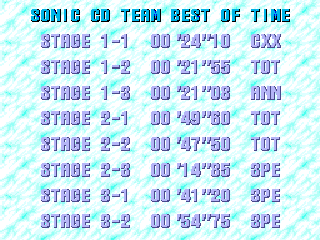
Play With The Clouds
At the title screen hold down BUTTON A and press UP, DOWN, DOWN, DOWN, DOWN then UP. Use Controller 2 to change the appearance of the clouds. They can be zoomed and rotated.
This is not known to work in the PC version.
Instant Death
Pause the game and Press BUTTON A, B or C to kill Sonic. This is useful if you wish to return to a save point.
EMULATOR COMPATIBILITY
Works perfectly with the latest versions of KEGA Fusion, Gens and Gens32. These can be downloaded from the Mega-CD/SEGA-CD emulators page.
OTHER VERSIONS
PC Version

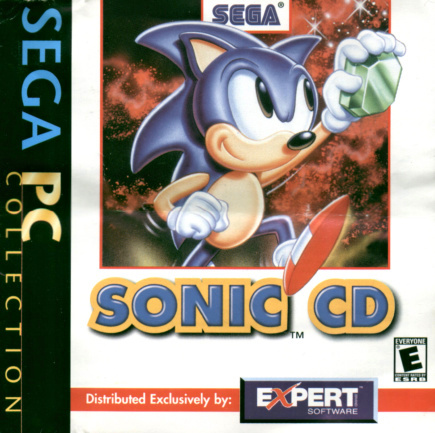
Released in 1996 under the SEGA PC brand, this was the first port of the game (since emulation barley existed at the time) to another platform. Why SEGA chose to port this game is anybodies guess.
All PC versions of the game officially used the US soundtrack and between zones loaded the graphic of Little Planet (D.A Garden) was displayed rather than a black screen.
For reference, these are the official system requirements:
Windows 95
Pentium 75Mhz
8MB RAM
SVGA 256 colours
2X CDROM Drive
Soundblaster 16 or compatible soundcard
Optional Gravis PC game pad, keyboard or mouse.
There are actually two builds of the game using different methods to display the graphics: one programmed using DINO libraries and a later version which uses DirectX - a burgeoning standard in programming at the time. The actual game content is the same.
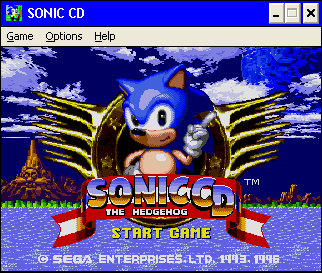
Demo's were included on magazine cover CDROM's of the time but did not include any music.
Both versions of the game use lower quality and scratchy sound effects.
This version suffers from a graphical glitch in Tidal Tempest: the water is the wrong colour! The water is clear rather than green which is seen in the console version when Sonic is submerged.
It was also the version included in the Sonic Gems Collection.
With the advent of the remastered version available on Steam, this original port is essentially obsolete, however, it is still possible to play on PC's running Windows XP. See the guide below.
It is fairly simple to create custom versions with the Japanese soundtrack but note that the animations will still have their US background music. All I did was create a mixed-mode CDROM and change the audio tracks. Refer to your burning program on how to do this.
Cheats
The program is sensitive to the timing of entering these cheats. Enter these at a gentle pace. You will see "Press Start" flash again with each registered key press.
The directions described relate to the arrow/cursor keys by default.
Stage Select
At the title screen press UP, DOWN, DOWN, LEFT, RIGHT, SPACE.
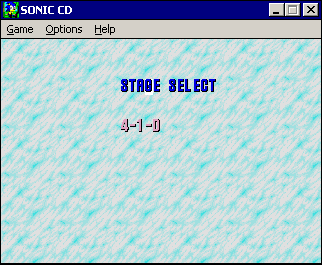
Sound Test
At the title screen press DOWN, DOWN, DOWN, LEFT, RIGHT, SPACE
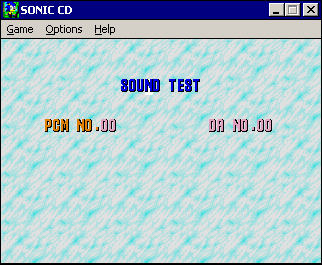
Programmer Scores
At the title screen press RIGHT, RIGHT, UP, UP, DOWN, SPACE.
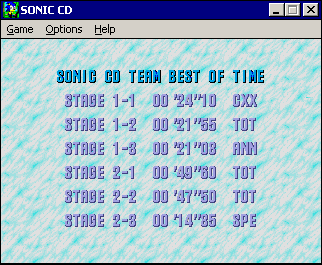
Debug Mode
At the title screen enter the Sound Test cheat (above) and select PCM12, DA11. An image of Tails will appear.
Press SPACE to return to the title screen. Start/Continue a game or enter the level select cheat. When the game starts the score will be hexadecimal values.
During this mode, press ESC to change Sonic into an object, SPACE to change into another object and C to place that object onto the screen.
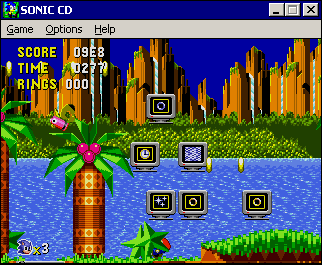
Extra's
Activate the sound test mode, set the following numbers and press SPACE.
PCM07, DA07 Secret Special Stage (8)
PCM12, DA11 See You Next Game
PCM03, DA01 DJ Sonic
PCM04, DA21 Demonic Sonic
PCM12, DA25 SEGA Forever
PCM11, DA09 Yuakuru
Extra Menus
Locate the SONICCD.INI file (usually in your Windows folder) and add the following block.[Secret]
User=Debugger
Save the file and restart the game. Two new menus will appear. The Stage menu will allow the selection of any stage (including Special Stage 8) and the FUNC menu can turn on debug mode, turn off special stage timer, record and play demos and the MMTimer option can adjust the speed of the game. There are several other programmer specific options also.
Playing with Windows 2000 and XP
The PC version of Sonic CD is pretty obsolete with its Windows 9X origins yet with some trickery can be made playable on Windows 2K/XP(SP3).
This could be done with moving DLLs and registry mods but someone has kindly created a patch to make this all very simple. You can download the patch created by Korama here.
This procedure will allow the game to run and use CD audio.
Procedure:
Insert the Sonic CD CDROM.
If enabled, Autorun will fire up the installer which will promptly crash. (ssp.exe - Entry Point Not Found). Quit the installer (blue background) that may appear after.
Create a folder called SONICCD or similar on your hard drive.
Explore/open the Sonic CD CDROM and open the folder called GAME.
Copy the entire contents of this folder to the folder just created on your hard drive. This should be approx. 150MB in total. Note: If you are extracting from an ISO or similar disc image then extract the contents of GAME to the folder just created.
Move/Copy the Sonic CD Patch (soniccdfix.exe) into this folder also and execute.
Locate the soniccd.exe. It will be inside the folder you created on your hard drive.
Click the apply patches button.
Click yes to the prompt to create a Soniccd.ini if prompted.
Click Exit.
Find the soniccd.exe in your folder and launch. You may wish to create a shortcut to this file.
There maybe a few seconds delay between the display mode being switched and the game starting but it should run without needing to use the Program Compatibility Wizard.
If you have more than one CD/DVD drive in your pc you must be sure to put the Sonic CD CDROM in the same drive you just used in order for the CD audio to work when playing again.
Some video card drivers have issues when using the fullscreen mode (F4) so a windowed game maybe all that is possible.
For reference, the screenshot below shows the contents of the GAME folder of the CDROM.
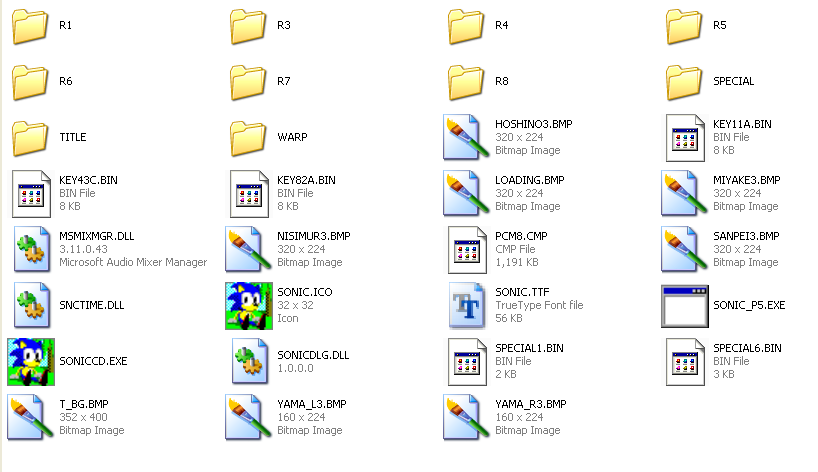
REMASTERED VERSIONS

Released in 2011, a remastered version created from the efforts of Christian "The Taxman" Whitehead using a custom engine was released Xbox 360, PS3 and mobile platforms in digital format. A version was released for the Ouya console in 2013. It is fairly cheap to buy and Sonic CD Lite is a free very limited playable version for android devices (phones).
This version is neither a port or an emulator package instead it is a rebuilt game. This has allowed a number of enhancements summarised below:
- HD Graphics and filtering options
- Widescreen Support
- Smooth 60 Frames per second
- Option to select between the Japanese/European and US soundtracks.
- Sonic 2 style Spin-Dash option.
- Tails as a playable character when the game has been completed.
- Online leader boards
A psychedelic menu system that uses some sprites from the game organises options and extra content. It is not possible to enter cheats.
There are the tiniest of changes to the gameplay in the form of tweaks to graphics the zones but nothing that even ardent fans of the original would notice. It is very faithful to the original.
More noticeable changes are those to the music. An example is the bulk of the lyrics from the videos have been removed presumably due to licensing reasons and there are some slight changes to the soundtracks with the addition of a new song for the Time Attack menu (for Japanese/European mode) which an instrumental remake of "Brand-new World" from Sonic the Hedgehog - Remix, a soundtrack that was released in 1994 to accompany the original edition of the game.
Xbox 360 Achievements
Detailed below are the achievements for the Xbox 360 version.
Name |
Description |
Gamer Points |
88 Miles Per Hour |
Travel Through Time |
5 |
Just One Hug Is Enough |
Get a hug from Amy |
5 |
Paradise Found |
Complete a zone in the Good Future |
5 |
Take The High Road |
Pass the upper Signpost in Collision Chaos Zone 2 |
10 |
King of the Rings |
Collect 200 Rings |
10 |
Statue Savoir |
Find the angel statue in Wacky Workbench |
10 |
Heavy Metal |
Defeat Metal Sonic without getting hurt |
15 |
All Stages Clear |
Finish the game |
15 |
Treasure Hunter |
Collect all the Time Stones |
20 |
Dr. Eggman Got Served |
Destroy Dr. Eggman's final machine |
30 |
Just In Time |
Complete the Time Attack mode in under 25 minutes |
35 |
Saviour Of The Planet |
Destroy all the robot teleporters and Metal Sonic holograms in the past |
40 |
A new zone was planned to be in this version called Desert Dazzle but ultimately scrapped. A concept image of this can be seen by entering PCM: 32, DA: 8 on the Sound Test. It also enables Tails while choosing a stage from the Stage Select menu.
This zone was perhaps to plug the hole left by the lost R2 zone - possibly Sonic CD's biggest secret.
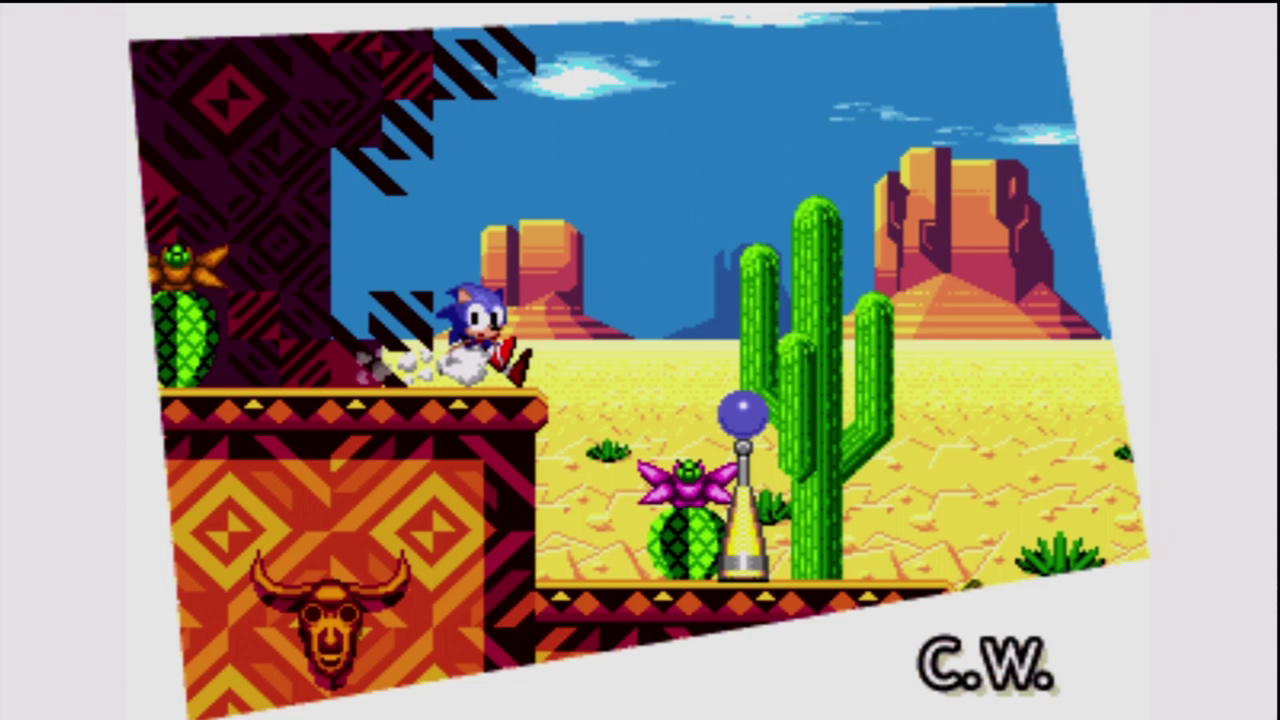
Desert Dazzle
Unlockables
Tails Playable - Beat the game one time.
Special Stage Time Attack - Clear every level in normal Time Attack mode (including bosses).
Extras Menu
D.A. Garden - Clear Time Attack mode with a combined total of 25 minutes or under OR Clear main game with all 7 Time Stones (needs confirmation).
Visual Mode - Clear Time Attack mode with a combined total of 25 minutes or under.
Sound Test - Clear Special Zone Time Attack with a combined total of under 4 minutes.
Stage Select - Clear Special Zone Time Attack with a combined total of under 5 minutes.
SOUNDTRACKS
Official
Sonic The Hedgehog CD Original Soundtrack 20th Anniversary Edition.
There was an official release made of the Japanese/European soundtrack for Sonic's 20th anniversary. It is available from Amazon and http://www.otaku.co.uk/.
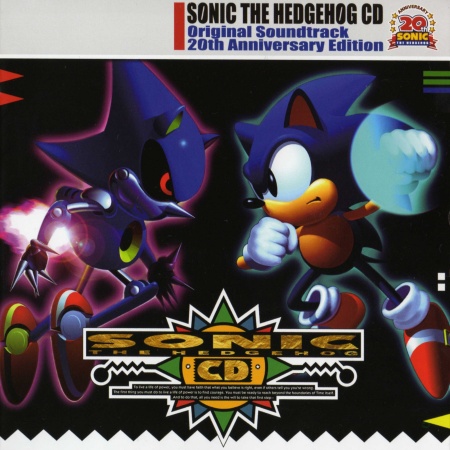
Track |
Description |
1 |
Sonic - You Can Do Anything |
2 |
Title |
3 |
Little Planet |
4 |
Palm Tree Panic |
5 |
Palm Tree Panic "G" Mix |
6 |
Palm Tree Panic "P" Mix |
7 |
Palm Tree Panic "B" Mix |
8 |
Collision Chaos |
9 |
Collision Chaos "G" Mix |
10 |
Collision Chaos "P" Mix |
11 |
Collision Chaos "B" Mix |
12 |
Tidal Tempest |
13 |
Tidal Tempest "G" Mix |
14 |
Tidal Tempest "P" Mix |
15 |
Tidal Tempest "B" Mix |
16 |
Quartz Quadrant |
17 |
Quartz Quadrant "G" Mix |
18 |
Quartz Quadrant "P" Mix |
19 |
Quartz Quadrant "B" Mix |
20 |
Wacky Workbench |
21 |
Wacky Workbench "G" Mix |
22 |
Wacky Workbench "P" Mix |
23 |
Wacky Workbench "B" Mix |
24 |
Stardust Speedway |
25 |
Stardust Speedway "G" Mix |
26 |
Stardust Speedway "P" Mix |
27 |
Stardust Speedway "B" Mix |
28 |
Metallic Madness |
29 |
Metallic Madness "G" Mix |
30 |
Metallic Madness "P" Mix |
31 |
Metallic Madness "B" Mix |
32 |
Boss!! |
33 |
Final Fever |
34 |
Zone Clear |
35 |
Speed Up!! |
36 |
Invincible!! |
37 |
Game Over |
38 |
Special Stage |
39 |
Cosmic Eternity - Believe In Yourself |
40 |
Sonic Boom |
41 |
Stardust Speedway (Cash Cash vs. Jun Senoue) |
42 |
Sonic Boom (Crush 40 vs. Cash Cash) |
Ripped For Download
All tracks from both soundtracks can be downloaded on the Soundtracks page in MP3 format.
You Can Do Anything Lyrics
10-10 Y' can go again
9-9 Don't fall behind
8-8 Say, don't be late
7-7 Destination heaven
6-5 Stay alive
4-3 Now it's you and me
2-1 We're gonna have fun
Say "blast off!" - Hey!!
Excalibar - It's not that far
What do y'make - Give and take
Goin' home - Time zone - Check out Egg
He's never alone
Leather 'n' Lace - Kickin' his booty
What do y'get - Say - Fast jet!
Doom room - Cosmic zoom - Heads up, Jake
It's Sonic Boom!
Toot-toot, Sonic Warrior - toot-toot, Sonic Warrior
Your hour is near at hand
You've got the power to save the land
Take a little chance - slip on through
Y'gotta survive no matter what you do
You gotta do for you
Toot-toot, Sonic Warrior - Toot-toot, Sonic Warrior
The power is in your mind
To shake the planets and conquer time
Toot-toot, Sonic Warrior - deep in space and time
Toot-toot, Sonic Warrior - forever in your mind
Nothing can survive the will to stay alive
'Cause if you try, you can do anything!
Toot-toot, Sonic Warrior - always takes a chance
Toot-toot, Sonic Warrior - never says he can't
Nothing can survive the will to stay alive
'Cause if you try, you can do anything!
This song is also known as Toot-Toot Sonic Warriaor my many.
Lyrics and additional vocals by Casey Rankin. Performed by Keiko Utoku.
Sonic Boom Lyrics
Lyrics for the animated intro in the US version of the game. You can download the song from the Sonic CD Soundtracks page.
If you're strong you can fly
You can reach the other side of the rainbow
It's all right, take a chance, 'cause there is no circumstance
That you can't handle (when you use your mind)
Mr. Bad's got it good
But this ain't his neighbourhood
He's takin' over ... no, no
Time is now, he can't hide
Find the power deep inside and make it happen
Sonic Boom, Sonic Boom
Trouble keeps you runnin' faster, Sonic Boom
Save the planet from disaster, Sonic Boom
Spinning through the world in motion, Sonic Boom
Take it all the way
Make your move, break it out
That's what life is all about
It's your adventure from the dark to the light
On a supersonic flight, gotta keep it going
Sonic Boom, Sonic Boom
Trouble keeps you runnin' faster, Sonic Boom
Save the planet from disaster, Sonic Boom
Spinning through the world in motion, Sonic Boom
Take it all the way
Music by Spencer Nilsen
Lyrics by Spencer Nilsen and Pastiche
MISC INFO
- Release Dates:
Europe - October 1993
US - November 19th 1993
Japan - September 23rd 1993 - Sonic CD was the first game to us alliteration in its zone names. The next was Sonic R.
- Other Sonic games to involve Time Travel was the appalling Sonic The Hedgehog '06 (Xbox 360 and PS3) and Sonic Generations (Multi).
- The race with Metal Sonic was recreated for a boss encounter in Sonic Generations. It is also possible to select some tunes of Sonic CD to play.
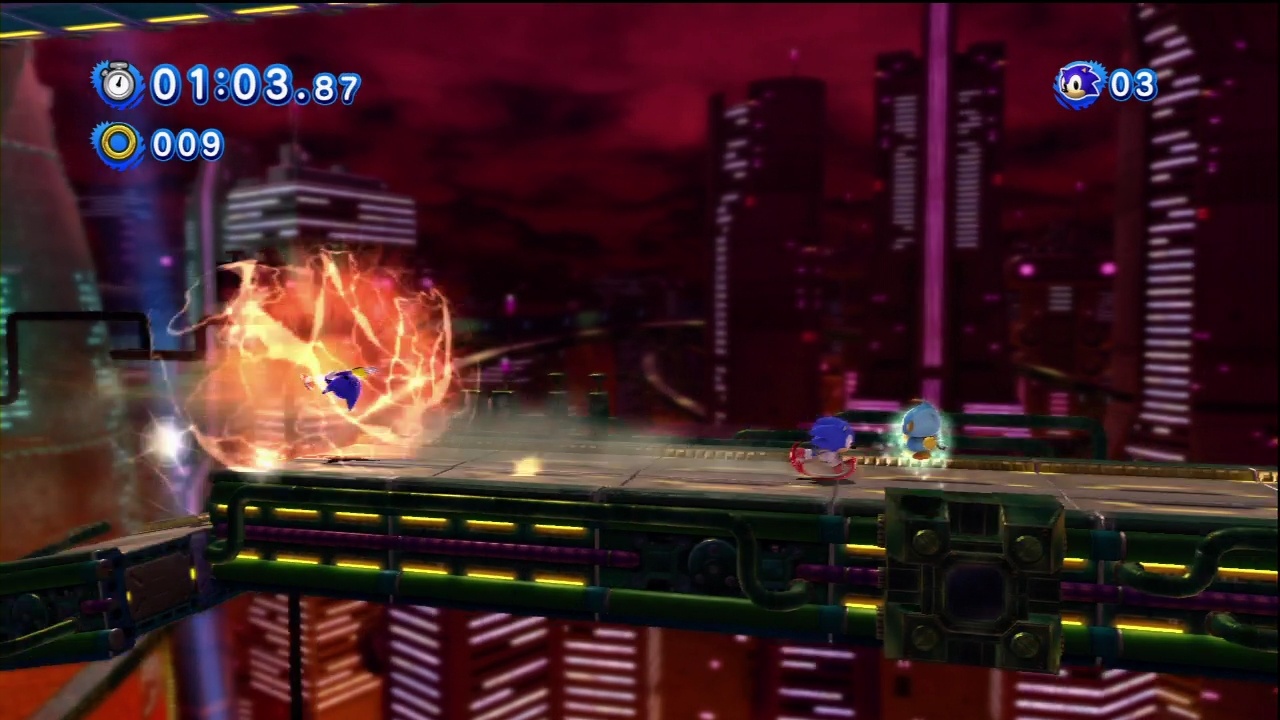
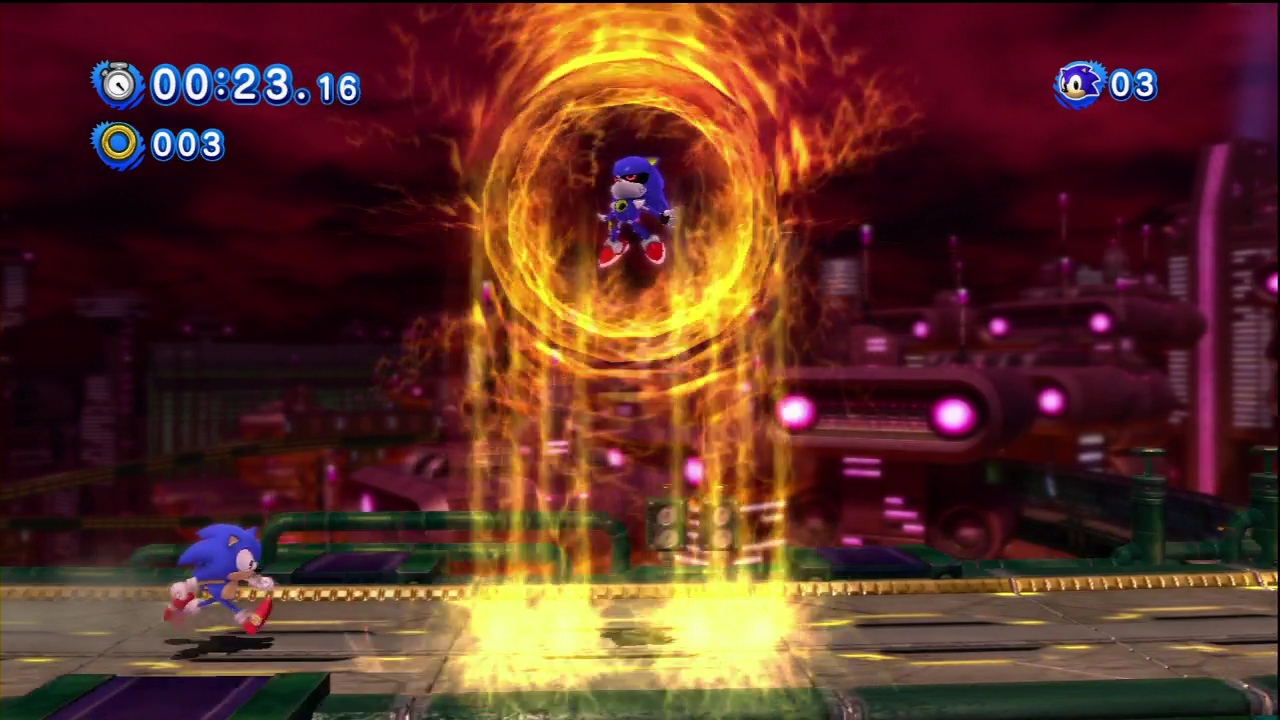
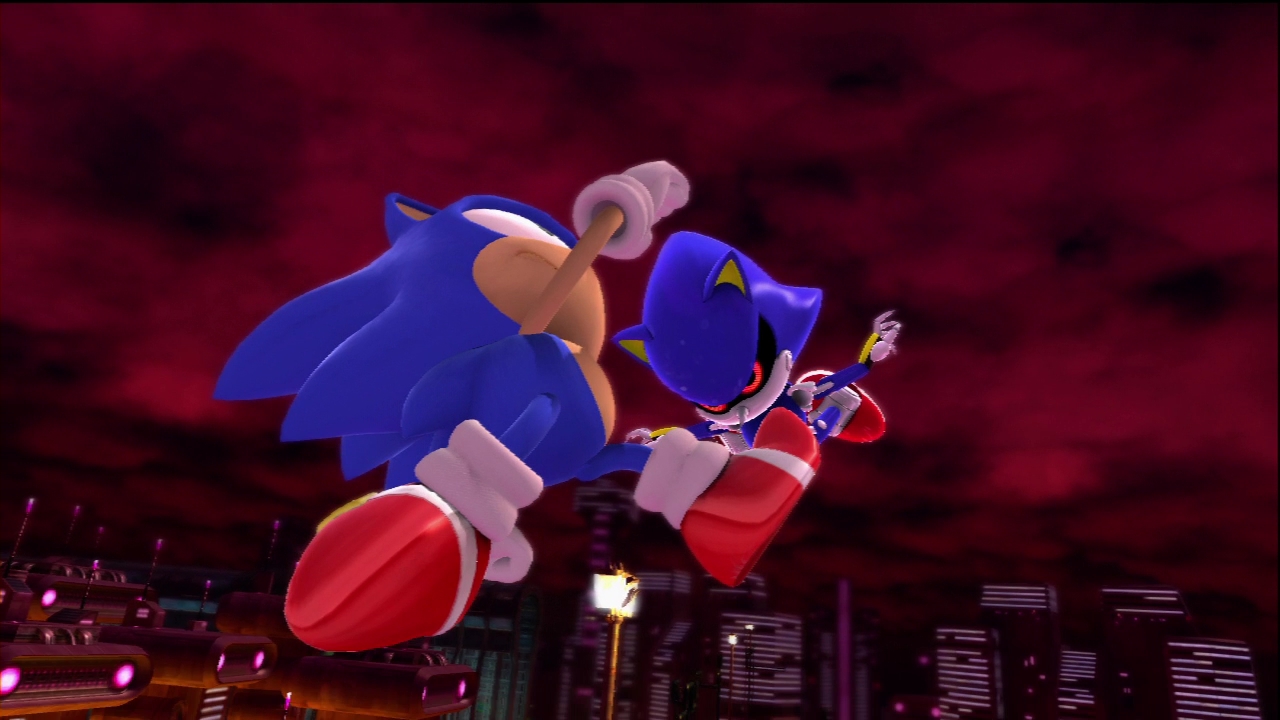
- There are remnants in Sonic Mega Collection (the compilation prior to Sonic Gems Collection) of plans to include Sonic CD.
- The video sequences were some of the early examples of FMV on the system and as such use uncompressed tiles.
- The opening and ending video sequences were included in Sonic Jam for the Saturn, Sonic Mega Collection and Sonic Mega Collection Plus on multiple platforms. These were the full versions unlike the Mega-CD/SEGA-CD version which were cut somewhat due to hardware limitations.
- Spencer Neilsen created several soundtracks for games. Another of which was for Ecco 2: The Tides of Time on the Mega-CD/SEGA-CD.
- The custom sprite scaling chip inside the system an Application-Specific-Integrated Circuit (ASIC) of SEGA custom design and operates with the VDP of the Mega Drive/Genesis. It adds a variety of hardware processed sprite functions such as scaling and rotation, bi-axial scaling and rotation and super smooth sprite animation. All of these features directly matched that of the Super Nintendo's MODE7 abilities. Most of the best games on the platform used these features to the fullest.
- The sound effect for the Spin Dash and Peel Out is a little buggy and tends to continue to sound when the animation is completed.
- The blue ring monitor is an inactive object found in Debug Mode. It can also be found in Knuckles' Chaotix.

- In 2009, a Sonic Community member called TheBuilder created a high quality DVD video application entitled "The Sonic CD DVD" that examined many aspects of the game such as it's history and included the different versions of the opening and ending video sequences in high quality.
- It can be found online and is a whopping 6GB to download. More information can be found at http://www.tssznews.com/2009/04/21/sonic-cd-dvd-a-go/.
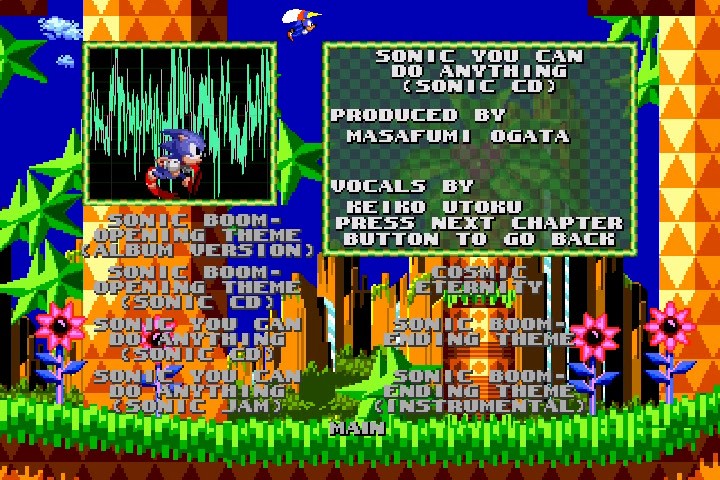

- Metal Sonic returned in Sonic The Hedgehog 4 Episode 2 even having his own episode. He returned again after a long absence in Sonic Heroes.
- Christian Whitehead aka "The Taxman", responsible for the remastered version is set to release a remastered version of Sonic The Hedgehog for the Mega Drive/Genesis initially on iOS in 2013.
- The only other Sonic game on the Mega-CD/SEGA-CD is an unofficial project entitled Sonic The Hedgehog Megamix. It can be downloaded and played on real hardware. It is still an ongoing project. The official website is http://teammegamix.com
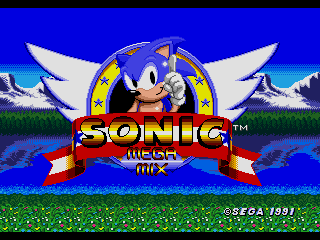
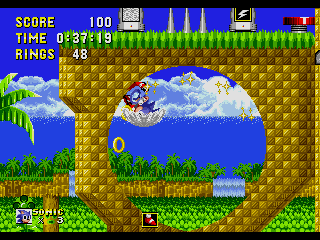
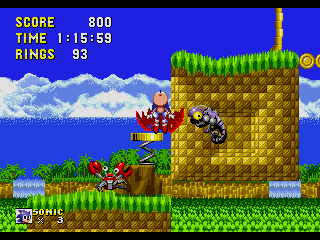
Secrets of Sonic CD
As with Sonic 2, anyone who delved a little deeper into the game or certainly used the Debug Mode or placed the CDROM of either the PC or console version into their CDROM and explored the disc found that Sonic CD had plenty of secrets of its own!
There are many community pages devoted to this but some examples are:
- The missing R2 directory on the CDROM - A scrapped zone!
- The S Monitor in Debug Mode - Super Sonic mode not used!

- The Clock Monitor in Debug Mode - Originally used for Time Travel?

- The Blue Ring Monitor in Debug Mode - A special ring?

- The unused CD audio track 2 - A lost intro?
- Unused sprites of Sonic and enemies.
- What is coming soon when selected in the Level Select? A Beta hangover?
Sonic CD Beta Versions
There are three known development versions of the Sonic CD known to exist. They are labelled upon they dates they were revealed to the press or as demos. Early screenshots came from these builds.
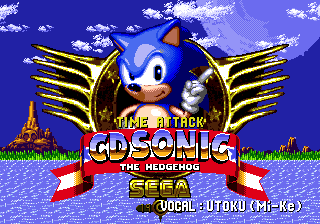
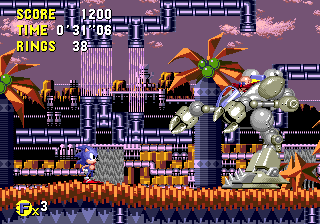
Sonic CD Beta
For those wishing to investigate, these can still be found online through Sonic community websites. It maybe possible to get them from http://www.sonicstrike.net/users/sonicroms
Version 510 10/05/1993
This earliest of versions contains 3 incomplete levels. The title screen is distinctly different from the final version as are some of the music and some sound effects.
Keiko Utoku is credited on the title screen.
The lost R2 zone has been scrapped by this point.
Version 712 12/07/1993
This is a relatively complete version. There are a few differences between this and the final version though it has incomplete levels.
Version 920 20/09/1993
This is a complete version of the US game yet with the original Japanese soundtrack. The game though is identical to the final version. This should be considered a pre-release.
Credits
Executive Producer
Hayao Nakayama
Producers
Minoru Kanari
Makoto Oshitani
Director
Naoto Ohshima
Program Director
Keiichi Yamamoto
Art Director
Hiroyuki Kawaguchi
Sound Director
Yukifumi Makino
Game Designers
Hiroaki Chino
Kenichi Ono
Yuichiro Yokoyama
Takao Miyoshi
Akira Nishino
Character Designer
Kazuyuki Hoshino
Landscape Designers
Hiroyuki Kawaguchi
Takumi Miyake
Masahiro Sanpei
Masato Nishimura
Hideaki Kurata
Special Stage Designers
Kazuyuki Hoshino
Yasushi Yamaguichi
Special Stage Progammer
Keiichi Yamamoto
Animation Programmers
Yuichiro Mine
Eiji Horita
Animation Visual Directors
Hiroyuki Kawaguchi
Masahiro Sanpei
Visual Design
Kazuyuki Hoshino
Takumi Miyake
Chief Programmer
Matsuhide Mizoguchi
Programmers
Yuichi Matsuoka
Hiroshi Takei
Tatsuya Satoh
Noritaka Yakita
Sound Effects
Yukifumi Makino
Sound Programmer
Yukifumi Makino
Music (Original)
Naofumi Hataya
Music (US)
Spencer Nilsen
LINKS
These are some link for other Sonic CD related pages.
Sonic Zone0
A superbly presented website with a focus on the earlier Sonic games with in-depth articles.
Page at Emulation Zone
An excellent page on Sonic CD on an excellent website.
http://ghz.emulationzone.org/sonic/cd/sonic_cd.html
A Fan Website
http://www.jan-rehschuh.de/soniccd/tt/engl_index.htm
Sonic ROMS/Stuff - Download BETA
You can download the Beta version of the game from this site.
http://www.sonicstrike.net/users/sonicroms/
Original Sonic CD Beta Site
A direct link to the files. Be sure to look round the rest of the site. The author is a cool guy and allowed me to get these files many years ago.
http://www.mooglecavern.com/segasonic/scdbeta/
Sonic CD Beta Page
http://www.emulationzone.org/projects/scdbeta/SonCDB.htm
Reviews
A collection of reviews at GameFAQs. Some good and some not so good for balance.
Related
Mega-CD/SEGA-CD Console Feature
My Story
I first found out about Sonic CD in my Sonic The Hedgehog 2 Solid Gold guide which has screenshots of a beta version of the game. It was several years later before I actually was able to play it.
I loved this game when I got it after being captured by a colourful spread in Mean Machines SEGA and a giant catalogue in the Official SEGA Magazine.
The game felt a little buggy to play, but to me that added to its charm knowing that it was running on somewhat experimental hardware.
Unfortunately, my copy of Sonic CD became scratched by a random event with a dog. In Europe, copies of the game quickly became scarce (as did most things relating to the Mega-CD).
Not deterred I wrote letters to game suppliers (the now defunct Gameplay) and even SEGA Europe themselves (one of the first occasions of dealing with idiots at SEGA Europe as they were called back then) and it was several years before I got my hands on a working copy which I bought an extra console.
I'm a fan of the European/Japanese soundtrack by the way.